Harriet Gardiner (b.1821 - d.1892)
Landowner/Landlord
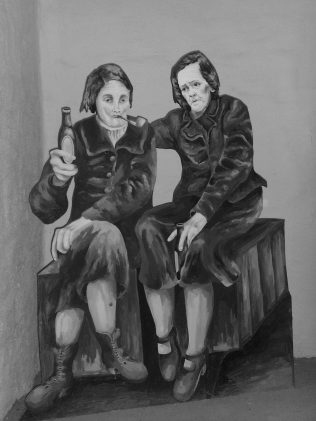
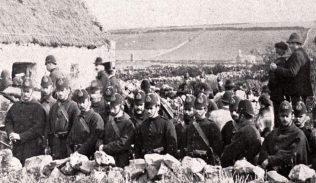
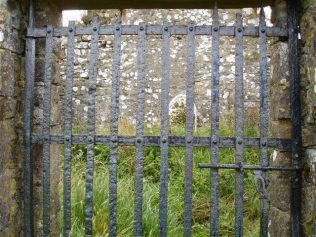
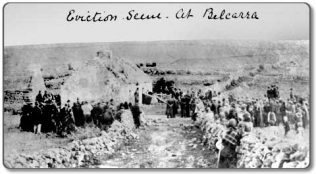
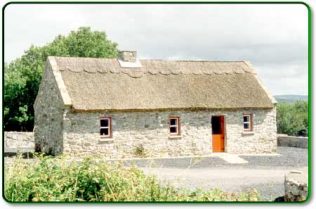
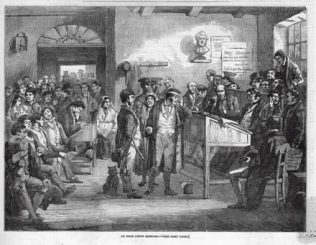
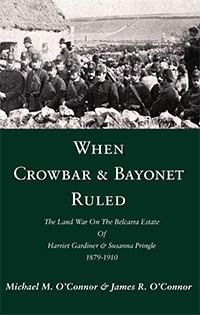
Introduction
Harriet Gardiner was born in the parish of Ballysakerry in north Mayo on July 21st 1821. While little is known of her early life, by the time she died in 1892 the reality of that life had already become cloaked in considerable myth and legend. When this cloak is removed what is revealed is one of the most notorious and reviled characters in the history of the Irish land troubles. Almost 100 years after her death tales of the terrible deeds of Miss Gardiner and her lifelong cohort Miss Pringle were still being whispered across the whitethorn ditches and ancient limestone walls along the many lanes that criss-cross the multitude of fields and townlands in and surrounding her estates at Farmhill and Belcarra. The deeds of Harriet Gardiner are chronicled in considerable detail in the press of the time. The Connaught Telegraph marked her passing with the following comment:
The dismal tragedy of her life and the Nemesis of its close ought never to be forgotten. She occupies a unique niche, even in the temple of that dark pantheon which is filled with the ghosts of Irish landlordism.
Early Life
Harriet Gardiner was the only surviving child of Elizabeth Cuffe, daughter of James Cuffe (1747 -1821), Baron of Tyrawley, and John Gardiner of Farmhill, Killala. Elizabeth died before Harriet’s second birthday. Nine years later her father married Eleanor Knox Gore. They had a large family. Sources suggest that the young Harriet learned to hunt, fish, shoot and drink with her uncle St. George Cuffe at Deel Castle near Crossmolina. Many years later George Moore would question how Gardiner, a blue eyed beauty, who had fallen in love with a painter, could have descended into the depths of debauchery that she found herself in during the latter years of her life. According to Moore’s account, her father objected to the marriage with the painter and though Gardiner protested she was destined for life as a spinster. In light of her position in her father’s new family, it is not clear how Gardiner secured the family estate at Farmhill though it is thought that she did so with the assistance of Susanna Pringle after the Gardiner family lost control of it during the famine. By the age of 35 Gardiner had become a significant landowner in Mayo. By 1876 she owned 4,037 acres in the County.
Gardiner the Lady
Gardiner’s prowess as a herds’ woman was acknowledged by her friends and foe alike. She frequented fairs, personally examined animals and closed out the bargains with the dealers. She had a reputation for very coarse language and spitting but it was her masculine dress that was the subject of much gossip and press commentary. She wore a man’s corduroy trousers, a felt hat and parted her hair after the fashion of men. She smoked a pipe and her beverage of choice was whiskey. She was frequently drunk and abusive in public and travelled the roads of Mayo on a soiled mattress on the back of a horse drawn cart accompanied by Pringle, her bailiff and an armed escort.
Farmhill
The Gardiner family residence at Farmhill was built in 1780. John Gardiner, Harriet’s father was referred to locally as the first of the “exterminators”. When Harriet secured the estate she looked to the farming techniques of Lord Lucan and the Marquis of Sligo and set about clearing the estate of tenants to make room for grazing cattle. Newspaper reports and court records of the time contain accounts of the many evictions at Farmhill, Killala, Ballycastle and elsewhere. Whilst Gardiner’s conflict with her tenants ultimately resulted in her clearing the estate at Farmhill, it came at a high a price for her. On Christmas Eve 1869 she survived an attempt on her life when shots were fired through her kitchen window at Farmhill.
Grains of shot caught her in the forehead but the main force of the effort found a home in furniture in the kitchen. Defiant Gardiner turned up in court bandaged and brandishing 2 pistols. In 1880 she was mobbed on the streets of Ballina and again had recourse to her pistols to defend herself. Gardiner was ultimately and effectively boycotted. The police hut erected outside the gates of Farmhill protected her from any further attempts on her life but it proved utterly ineffective against the boycott. Staff left and the house fell into serious decline and disrepair. In January 1881 a troop of Orange Men from Ulster travelled to Farmhill to relieve Gardiner but it was too late to save Farmhill. All seemed lost but Gardiner had been lucky in the past in matters of land and inheritance.
Belcarra
In 1883 Gardiner’s uncle George Cuffe died and Gardiner inherited his estate at Belcarra. She would dedicate the final 9 years of her life to clearing that estate of tenants. With the assistance of Pringle, her bailiffs and the Royal Irish Constabulary (RIC), Gardiner utterly and systematically destroyed many of the communities on the Belcarra Estate. She succeeded in turning neighbours and family members against each other as tenants were beaten, imprisoned, driven to the Workhouse at Castlebar where they died; or emigrated to the UK and US where they were all but forgotten. This was all done under the watchful eye and with the considerable assistance of the authorities. There is no doubt but that Gardiner could not have achieved her objectives without the assistance of the RIC who stood by in considerable numbers and witnessed and facilitated the forced eviction, beating and humiliation of men, women and children. The communities at Frenchill, Logaphuill, Tully and Elmhall were at the front line of Gardiner’s assault and her actions in these townlands resonated for generations. Gardiner and Pringle ultimately moved from Farmhill to Tully a few miles from Belcarra and built a cottage there with the stones of demolished cabins. Her bailiff William Cuffe lived next door in the evicted homestead of the Macken family. While at Tully the RIC constructed and staffed a hut to protect the pair.
Tactics
Gardiner employed a wide range of tactics in her war against her tenantry. Evolving tenant friendly legislation of the latter part of the 19th Century mandated that a form of due process was required to be observed when evicting tenants. Gardiner surrounded herself with able lawyers such John Garvey of Ballina and others. The number of legal documents produced in furtherance of evictions must have kept clerks at the offices of Solicitors who were willing to assist Gardiner very busy.
Unlike her uncle George Cuffe, Gardiner refused to acknowledge the impossible economic circumstances of the late 1870s and 1880s and insisted on payment of rent in full. Those offering less were rebuffed. Her objective was not the collection of rent, she wanted to clear her estates of tenants and move to what was viewed as a more profitable enterprise, the grazing of cattle. Against this background rent arrears accumulated quickly. Hundreds of ejectment notices were issued and tenants lined the streets outside rent offices held periodically at places such as Ellison Street in Castlebar. Those that did not attend the rent office or who sought a deferment or a reduction inevitably ended up before the magistrates at Ballyglass, Castlebar, Westport and elsewhere. In the majority of instances the magistrates found in favour of Gardiner and an order for possession was secured. When tenants refused to leave they were forcibly ejected with their families and the cabins rendered uninhabitable. Tenants who returned after dark to shelter in the ruins were hunted down by Gardiner’s bailiff, prosecuted for trespass and in many instances imprisoned at Castlebar. Tenants who paid their rent and avoided eviction suffered multiple trespass actions over many years for trespass by their livestock.
Bailiffs
Though Gardiner employed several bailiffs to manage her estates, at any one time there was one carefully selected individual who led the charge against the tenants. The most notorious and vilified was William (Billy) Cuffe. It was suggested, though never acknowledged, that he was the illegitimate son of Gardiner’s uncle George Cuffe. Cuffe, from Ballina was Gardiners Bailiff on the Belcarra Estate for 5 years from late 1885. He personally oversaw the majority of evictions and demolitions and pursued men, women and children with equal vigour and brutality. Cuffe ultimately fell out with Gardiner and was escorted off the Belcarra Estate by Gardiner’s Ballina mafia led by a man by the name of Joynt.
Relationship with Susanna Pringle
Susanna Pringle was of Scottish ancestry and was born to a Presbyterian family in Bengal, British East Indies in 1826. It is not entirely clear how she made her way to Farmhill though it is thought that she joined the crusade to convert Catholics in north Mayo during the famine at a Model Farm at Ballinglen near Farmhill. However the friendship between Gardiner and Pringle was forged it lasted for the remainder of their lives. There is no suggestion from the historical record that their relationship amounted to anything more than companionship but together they travelled the roads of Mayo perpetually intoxicated, at times assaulting each other and often assaulting the police assigned to protect them. As Gardiner declined Pringle stepped into her shoes and assumed the role of manager of the Belcarra Estate.
Adversaries
A small number of tenants stood up to Gardiner with limited success. In this regard one man stands out. John Garvey of Tully put up considerable and sustained opposition to Gardiner and subsequently Pringle and as a consequence endured significant hardship. He was beaten, evicted and imprisoned on multiple occasions but he nevertheless held on to his holding and ultimately prevailed. The efforts of John Garvey of Tully and others would however be forgotten if it were not for Gardiner’s chief nemesis James Daly. Daly lived at Coachfield, a few hundred yards from Gardiner’s cottage at Tully. Daly, co-founder of the Land League, land agitator and advocate of tenant rights used his proprietorship of the Connaught Telegraph to bring to the attention of the world the almost daily atrocities of Gardiner and Pringle. It is suggested that Daly fell out with Gardiner and as a consequence pursued her at every opportunity. It is however more likely that Daly’s sustained campaign against her was motivated more by nationalist and humanitarian considerations consistent with the aims of the Land League than anything else.
Death and Legacy
Gardiner died in her cottage at Tully on 25 July 1892. Her remains were removed from the cottage under cover of darkness. Oral tradition tells us that her burial was difficult. The grave filled with water and the coffin did not fit resulting in a mound of earth being placed above the grave to conceal the coffin. An alternative suggestion is that the men employed to dig the grave used the money paid to them to get drunk. As one worked faster than the other the grave was deeper on one side so that the coffin was laid in on a slope. Gardiner’s Last Will and Testament left her estates at Belcarra and Farmhill to Pringle. Some 18 years later when Pringle herself died she was buried with Gardiner. Following Gardiner’s death the Freemans Journal reported:
Miss Harriet Gardiner, a notable figure in the history of the land agitation in the west of Ireland, passed away at her residence, Belcarra, yesterday, after a lingering illness. Her strained relations with her tenantry were frequently the subject of considerable litigation and newspaper comment; and Mr. G.A. Moore in his book, “Parnell and His Island” refers, under a nom-de-plume, to her eccentric habits and peculiar attire while parading the streets of Castlebar with a constabulary escort, as she was always under police protection. She was continually engaged in a land war with her tenantry, and her eviction campaigns are matters of history.
On 11 March 2013 over 120 years after the death of Gardiner, descendants of the tenants of Gardiner and Pringle gathered at Breaghwy House Castlebar close to the boundary of what was the Belcarra Estate for the launch of When Crowbar & Bayonet Ruled: The Land War on The Belcarra Estate of Harriet Gardiner & Susanna Pringle 1879 -1910, an account of the reign of the terrible pair.
© Michael M. O’Connor LL.B., LLM (Cantab.) 2015
Photograph: Artist Bridie Geraghty’s impression of Gardiner & Pringle (Reproduced with the kind permission of the Geraghty family.
BIBLIOGRAPHY
- Armstrong, Revd., Thomas “My Life in Connaught: with Sketches of Mission Work in the West” Elliot Stock, London, 1906.
- Becker, Bernard H., “Disturbed Ireland: Being the Letters Written During the Winter of 1880-81” Macmillan & Co. London, 1881.
- Burke, Bernard “A genealogical heraldic history of the landed gentry of Great Britain & Ireland”, Vol. II, Eight Edition, Harrison & Sons, London, 1894.
- Campbell, Fergus, “Land and Revolution, Nationalist Politics in the West of Ireland 1891-1921” Oxford University Press, Oxford, 2005.
- O’Connor, Michael M., and O’Connor, James R., “When Crowbar & Bayonet Ruled: The Land War On The Belcarra Estate Of Harriet Gardiner & Susanna Pringle 1879 – 1910” Original Writing, Dublin 2013.
- Dublin Mansion Relief Committee, “The Irish Crisis of 1879-80” Brown & Nolan, Nassau-Street, Dublin, 1881.
- Feingold, William L., “The Revolt of the Tenantry, The Transformation of Local Government in Ireland 1872-1886” Northeastern University Press, Boston, 1984.
- Jordan, Donald E., Jr., “Land and Popular Politics in Ireland, County Mayo from the Plantation to the Land War” Cambridge University Press 1994.
- Lavelle, Frank “Pringle & Gardiner Landlords” Balla/Belcarra/Manulla Magazine, Christmas, 1997.
- Moore, George., “Parnell and His Island”, Swan, Sonnenschein, Lowrey & Co., London, 1887.
- Quinn, J.F., “History of Mayo”, Vol. I, Brendan Quinn, Ballina, 1993.
- Quinn, J.F., “History of Mayo”, Vol. IV, Brendan Quinn, Ballina, 2000.







No Comments
Add a comment about this page